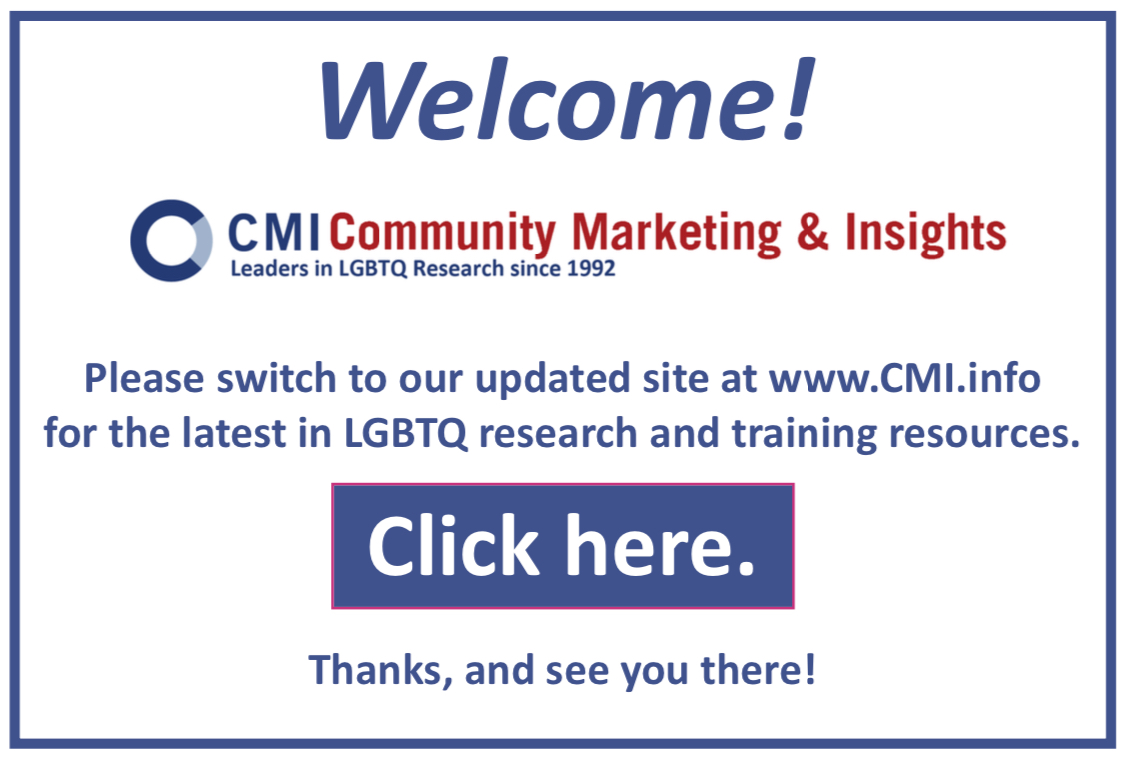10th Annual LGBTQ Community Survey, A Summary
10th Annual LGBTQ Community Survey, A Summary, Part 1
Community Marketing Insights’ (CMI) 10th Annual LGBTQ Community Survey gathered data from 8,800 gay and bisexual men, 3,400 lesbian and bisexual women, and 1,200 gender expansive participants living in the United States. Gender expansive includes transgender, trans men, trans women, genderqueer, gender fluid, non-binary and/or intersex.
The survey also distinguishes between three generational categories: Baby Boomer Plus (born 1942-1964), Generation X (born 1965-1980), and Millennials (born 1981-1998).
The LGBTQ demographics of generation and gender are important to differentiate because they often reveal deeper insights than total LGBTQ results.
Type of Community
 Living in big cities is more popular among gay and bisexual men than among other LGBTQ community members. Lesbian and bisexual women and gender expansive community members live more spread out in different types of communities.
Living in big cities is more popular among gay and bisexual men than among other LGBTQ community members. Lesbian and bisexual women and gender expansive community members live more spread out in different types of communities.
Among the three generations, Millennials are the ones with the highest preference for living in big cities due to better economic opportunities and easier access to LGBTQ resources.
LGBTQ-specific resources are more abundant in big cities, and for the first time the Annual LGBTQ Community Survey determined the LGBTQ resource gap: 73% of those living in a rural community reported that they had no access to LGBTQ resources such as a LGBTQ community center, business, sports, arts, or health organization.
Children
Within the LGBTQ community, far more women than men have children. Generation X lesbian and bisexual women have the highest parenting rate of children under 18. However, the number of Millennial parents is likely to grow in the future, since about half of Millennial lesbian and bisexual women and gay and bisexual men want to have children.
Perceptions of the Future
Overall, most in the LGBTQ community feel that their quality of life has improved in terms of social and cultural acceptance. When asked about the future, LGBTQ community members predicted that during the next ten years, a larger number of people will identify as gender expansive, non-LGBTQ straight allies, and bisexual. However, LGBTQ community members think that there will not be an increase in the number of LGBTQs living in LGBTQ neighborhoods, or in the number of LGBTQ-specific bars and LGBTQ newspapers.
Social and Political Issues Most Important to the Community
Regarding social and political issues, LGBTQ community members are most concerned about LGBTQ equality, followed by affordable healthcare, racial discrimination, and poverty. In general, equality issues are far more important than economic issues.
LGBTQ Economic Outlook
The LGBTQ community’s economic outlook overall is positive. 53% of respondents regard their economic situation positively, 32% are neutral, and 15% are negative. Millennials tend to be less confident than Baby Boomers about their economic situation, but on the whole, they are still optimistic.
Favorable Brand Recall
Every year, CMI’s LGBTQ research asks participants to recall if they made any conscious decisions to purchase from companies based on those companies’ pro-LGBTQ practices and policies. Target had a clear lead with 55% of community members reporting that they shopped there because of the company’s pro-LGBTQ practices. Although Target has been among the top three LGBTQ brands, their brand support in the LGBTQ community jumped from 20% in 2015 to 55% in 2016. This large boost resulted from the timing of the survey, which took place when Target was receiving extensive news coverage about their supportive transgender policies. These results clearly indicate that brands that choose to accommodate the LGBTQ community, and the transgender community specifically, can in turn garner support from the LGBTQ consumer market.
Request a complimentary download of the full 10th Annual LGBTQ Community Survey report.











